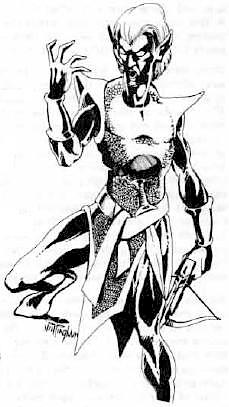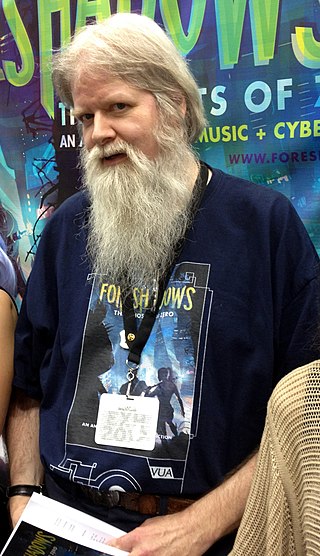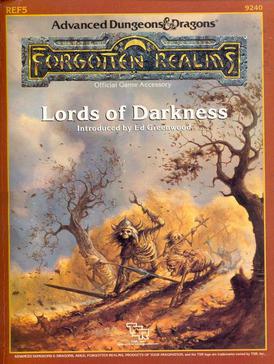Forgotten Realms is a campaign setting for the Dungeons & Dragons (D&D) fantasy role-playing game. Commonly referred to by players and game designers alike as "The Realms", it was created by game designer Ed Greenwood around 1967 as a setting for his childhood stories. Several years later, Greenwood brought the setting to publication for the D&D game as a series of magazine articles, and the first Realms game products were released in 1987. Role-playing game products have been produced for the setting ever since, as have various licensed products including novels, role-playing video game adaptations, comic books, and the film Dungeons & Dragons: Honor Among Thieves.

The drow or dark elves are a dark-skinned and white-haired subrace of elves connected to the subterranean Underdark in the Dungeons & Dragons fantasy roleplaying game. The drow have traditionally been portrayed as generally evil and connected to the evil goddess Lolth. However, later editions of Dungeons & Dragons have moved away from this portrayal and preassigned alignment. More recent publications have explored drow societies unconnected to Lolth.

Ed Greenwood is a Canadian fantasy writer and the original creator of the Forgotten Realms game world. He began writing articles about the Forgotten Realms for Dragon magazine beginning in 1979, and subsequently sold the rights to the setting to TSR, the creators of the Dungeons & Dragons roleplaying game, in 1986. He has written many Forgotten Realms novels, as well as numerous articles and D&D game supplement books.
Faerûn is a fictional continent and the primary setting of the Dungeons & Dragons world of Forgotten Realms. It is described in detail in several editions of the Forgotten Realms Campaign Setting with the most recent being the 5th edition from Wizards of the Coast, and various locales and aspects are described in more depth in separate campaign setting books. Around a hundred novels and several computer and video games use Faerûn as the setting.
Daedalus was a figure in Greek mythology.
Orpheus was a legendary figure in Greek mythology, chief among poets and musicians.
Avatar is a term used in Hinduism for a material manifestation of a deity. Other common uses include:
Aether, æther or ether may refer to:
Fate most commonly refers to destiny, a predetermined course of events.

Subterranean fiction is a subgenre of adventure fiction, science fiction, or fantasy which focuses on fictional underground settings, sometimes at the center of the Earth or otherwise deep below the surface. The genre is based on, and has in turn influenced, the Hollow Earth theory. The earliest works in the genre were Enlightenment-era philosophical or allegorical works, in which the underground setting was often largely incidental. In the late 19th century, however, more pseudoscientific or proto-science-fictional motifs gained prevalence. Common themes have included a depiction of the underground world as more primitive than the surface, either culturally, technologically or biologically, or in some combination thereof. The former cases usually see the setting used as a venue for sword-and-sorcery fiction, while the latter often features cryptids or creatures extinct on the surface, such as dinosaurs or archaic humans. A less frequent theme has the underground world much more technologically advanced than the surface one, typically either as the refugium of a lost civilization, or as a secret base for space aliens.
The flexibility of the Dungeons & Dragons (D&D) game rules means that Dungeon Masters (DM) are free to create their own fantasy campaign settings. For those who wanted a pre-packaged setting in which to play, TSR, Wizards of the Coast (WotC), and other publishers have created many settings in which D&D games can be based; of these, the Forgotten Realms, an epic fantasy world, has been one of the most successful and critically acclaimed settings. Many campaign settings include standard sword and sorcery environments, while others borrow Asian, Central American, swashbuckling, horror and even space-travel themes.
The Norse mythology, preserved in such ancient Icelandic texts as the Poetic Edda, the Prose Edda, and other lays and sagas, was little known outside Scandinavia until the 19th century. With the widespread publication of Norse myths and legends at this time, references to the Norse gods and heroes spread into European literary culture, especially in Scandinavia, Germany, and Britain. In the later 20th century, references to Norse mythology became common in science fiction and fantasy literature, role-playing games, and eventually other cultural products such as Japanese animation. Storytelling was an important aspect of Norse mythology and centuries later, with the rediscovery of the myth, Norse mythology once again relies on the impacts of storytelling to spread its agenda.
A siege is a military blockade and assault of a city or fortress with the intent of conquering. For a list of sieges, see list of sieges.
Cronus, also spelled "Cronos" or "Kronos", was the leader and the youngest of the first generation of Titans in Greek mythology.

Prey is a first-person shooter video game developed by Arkane Austin and published by Bethesda Softworks. It was released worldwide on 5 May 2017, for PlayStation 4, Windows, and Xbox One.

Forgotten Realms Adventures is an accessory for the Forgotten Realms campaign setting for the second edition of the Advanced Dungeons & Dragons fantasy role-playing game. The book, with product code TSR 2106, was published in 1990, and was written by Jeff Grubb and Ed Greenwood, with cover art by Clyde Caldwell and interior art by Steven Fabian, Ned Dameron, Larry Elmore, Caldwell, and Jeff Easley.

Lords of Darkness is the name of two accessories for the fictional Forgotten Realms campaign setting for the Dungeons & Dragons fantasy role-playing game.
Hercules is a Disney media franchise comprising a film series and additional merchandise, starting with the 1997 animated Disney feature of the same name, directed by Ron Clements and John Musker.

In the Dungeons & Dragons role-playing game, Corellon Larethian is the leader of the elven pantheon, and the god of Magic, Music, Arts, Crafts, Poetry, and Warfare. Corellon is also considered a member of the default D&D pantheon. Corellon is the creator and preserver of the elven race, and governs those things held in the highest esteem among elves. Corellon's symbol was originally a crescent moon; in the 4th edition Corellon's symbol is a silver star on a blue field.





